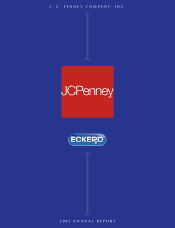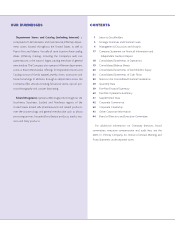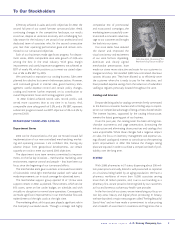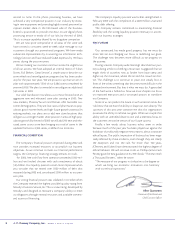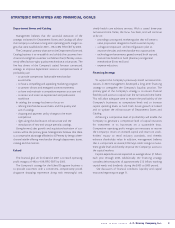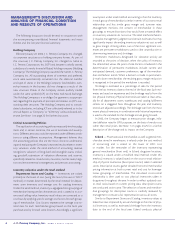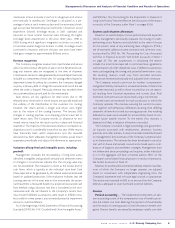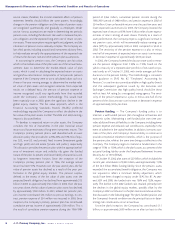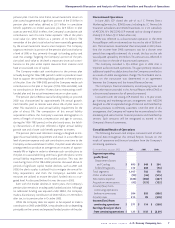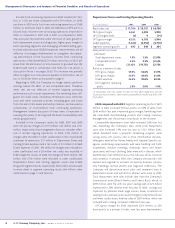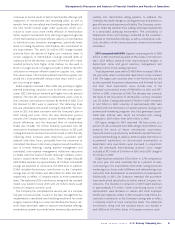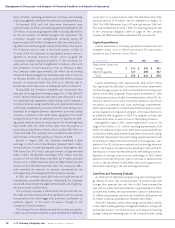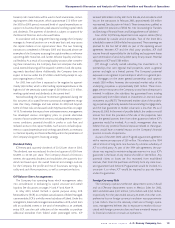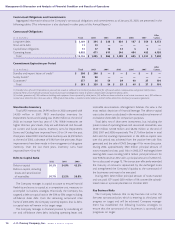JCPenney 2002 Annual Report Download - page 9
Download and view the complete annual report
Please find page 9 of the 2002 JCPenney annual report below. You can navigate through the pages in the report by either clicking on the pages listed below, or by using the keyword search tool below to find specific information within the annual report.
J. C. Penney Company, Inc. 2002 annual report6
Management’s Discussion and Analysis of Financial Condition and Results of Operations
service careers; therefore, the income statement effects of pension
retirement benefits should follow the same pattern. Accordingly,
changes in the pension obligation and the value of pension assets
are recognized systematically and gradually as employees render
service. Various assumptions are made in determining net periodic
pension costs, including the discount rate used to measure the pen-
sion obligation and the expected long-term rate of return on pen-
sion assets. These assumptions require significant judgment, and the
calculation of pension costs is relatively complex. The Company uti-
lizes third parties, including actuarial and investment advisory firms,
to help evaluate annually the appropriateness of the expected rate
of return, the discount rate and other pension plan assumptions.
In accounting for pension costs, the Company uses fair value,
which is the market value of the plan assets as of the annual meas-
urement date, to determine the market-related value of plan
assets, which is used in calculating the expected return on assets
and gain/loss amortization components of net periodic pension
expense. If the Company were to use a calculated value, such as a
three or five-year moving average, to determine the market-relat-
ed value of plan assets and recognize variances from expected
results on a delayed basis, the amount of pension expense or
income recognized could vary significantly from that recorded
under the Company’s current methodology. This would have
been especially true in 2002, given the significant decline in the
global equity markets. The fair value approach, which is the
Financial Accounting Standards Board’s (FASB’s) preferred
methodology, required the Company to reflect the decline in the
fair value of the plan’s assets in 2002. The 2002 and 2003 earnings
impact is discussed below.
To develop its expected return on plan assets, the Company
considers the mix of investments in the plan, historical actual
returns and future estimates of long-term investment returns. The
Company’s primary pension plan is well diversified with an asset
allocation policy that provides for a 70%, 20% and 10% mix of equi-
ties (U.S., non-U.S. and private), fixed income (investment grade
and high yield) and real estate (private and public), respectively.
This allocation provides the pension plan with the appropriate bal-
ance of investment return and volatility risk, given the funded
nature of the plan, its present and future liability characteristics and
its long-term investment horizon. Since the inception of the
Company’s primary pension plan in 1966, the average annual
return has been 9.1%. However, over the past several years, the fair
value of pension assets has declined as a result of the poor per-
formance in the global equity markets. The pension surplus,
defined as the excess of the fair value of plan assets over the
projected benefit obligation, has declined from approximately $1.2
billion in 2000 to approximately $50 million in 2002. Over the past
two years alone, the fair value of pension plan assets has declined
by approximately $700 million. In 2001, related net periodic pen-
sion income contributed $76 million to pre-tax earnings. In con-
trast, pension expense of $24 million was incurred in 2002. Since
inception, the Company’s primary pension plan has contributed
cumulative pre-tax income of approximately $100 million. This is
the result of cumulative pension expense during the 1966-1984
period of $366 million, cumulative pension income during the
1985-2001 period of $488 million, and pension expense in 2002 of
$24 million. Given unfavorable returns over the past few years and
lower expected future returns for 2003, the Company lowered the
expected rate of return to 8.9% from 9.5% to reflect lower expect-
ed rates of return among all asset classes. Primarily as a result of
asset performance, the Company expects a significant increase in
net pension costs, which will incrementally reduce earnings per
share (EPS) by approximately $0.25 in 2003 compared to $0.20 in
2002. The sensitivity of the pension expense to a plus or minus
one-half of one percent of expected return on assets is an increase
or decrease in expense of approximately $0.03 per share.
In 2002, the Company lowered the discount rate used to meas-
ure the pension obligation from 7.25% to 7.10%, based on the
yield to maturity of a representative portfolio of AA rated corpo-
rate bonds as of October 31, 2002, with similar average cash flow
durations to the pension liability. This methodology is consistent
with guidance in SFAS No. 87, “Employers’ Accounting for
Pensions,” to use the rate currently available on high quality bonds
and the subsequent guidance issued by the Securities and
Exchange Commission that high quality bonds should be those
with at least AA rating by a recognized rating agency. The sensi-
tivity of the pension expense to a plus or minus one-half of one
percent of the discount rate is an increase or decrease in expense
of approximately $0.05 per share.
Pension funding — The Company’s funding policy is to
maintain a well funded pension plan throughout all business and
economic cycles. Maintaining a well funded plan over time pro-
vides additional financial flexibility to the Company, including lower
pension expense and reduced cash contributions, especially in the
event of a decline in the capital markets. In addition, it ensures asso-
ciates of the plan’s and Company’s financial ability to continue to
provide competitive retirement benefits, which is the purpose of
the pension plan, while at the same time being cost effective to the
Company. The Company targets to maintain a funded ratio in the
range of 110% to 130%, which is the plan’s assets as a percent of the
actuarial funding liability under the Employee Retirement Income
Security Act of 1974 (ERISA).
At October 31, 2002, plan assets of $2.9 billion, which included the
current year contribution of $300 million, were approximately 112%
of the $2.6 billion ERISA funding liability. Since the pension assets
exceeded the accumulated benefit obligation, the Company was
not required to reflect a minimum liability adjustment, which
would have been charged to equity under SFAS No. 87. At year-
end 2001 and 2000, the funded ratio was 126% and 122%, respec-
tively. The decline in the 2002 funded ratio resulted primarily from
the declines in the global equity markets, partially offset by the
Company’s 2002 contribution to the plan mentioned above and fur-
ther discussed on the following page. The plan’s funded position and
the Company’s financial condition are the principal factors in deter-
mining cash contributions on an annual basis.
Since the plan’s inception, the Company has contributed $1.1
billion, or approximately $650 million on an after tax basis to the

